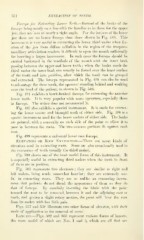Page 576 - My FlipBook
P. 576
574 EXTRACTION OF TEETH.
Forceps for E.vtr(ictin(/ Lower Teeth.—Instead of the beaks of the
forcej)s beiiii^ iiearlv on a line with the liandles as in those for the u{)[)er
jaw, they are bent at nearly a right angh'. For the incisors of tlie lower
jaw there are no better forceps than those shown in Fig. 489. This
instrnnient is very useful in extracting the lower third medlar when fix-
ation of the jaw from diifuse cellulitis in the region of the temporo-
maxillary articulation renders it difficult to open the mouth sufficiently
for inserting a larger instrument. In such cases the forceps should be
carried backward in the vestibule of the mouth with the inner beak
passing between the upper and lower teeth ; when the beaks reach the
third molar the inner beak can usually be forced over the inner surface
of the tooth and into position, after which the tooth can be grasped
and extracted. The forceps represented in Fig. 488 can also be used
to advantage for these teeth, the operator standing behind and working
over the head of the patient, as shown in Fig. 546.
Fig. 494 exhibits a hawk-beaked forceps for extracting the anterior
lower teeth. It is very popular with some operators, especially those
in Europe. The writer does not recommend it.
Fig. 497 also exhibits a special instrument. It is made for extract-
ing the lower canine and bicuspid teeth of either side. Fig. 498 is a
special instrument used for the lower molars of either side. The beaks
are pointed, with a convexity on each side of the point to allow it to
pass in between the roots. The two concave portions fit against each
root.
Fig. 499 represents a universal lower root forceps.
Elevators or Root Extractors.—There are many kinds of
elevators used in extracting roots. Some are also occasionally used in
the extraction of teeth (usually the third molar).
Fig. 500 shows one of the most useful forms of this instrument. It
is especially useful in extracting third molars when the teeth in front
of them are in position.
Fig. 501 represents two elevators ; they are similar to right and
left scalers, being made somewhat heavier ; they are extremely use-
ful in extracting roots. They are so unlike an extracting instru-
ment that patients do not dread the a])pearance of them as they do
that of forceps. By carefully inserting the blade with the point
toward the root to be removed, between it and the adjoining root or
tooth, and giving a slight rotary motion, the point will force the root
from its socket with but little pain.
Figs. 537 and 538 illustrate two other forms of elevator, with their
mode of application in the removal of roots.
Lancets.—Figs. 502 and 503 represent various forms of lancets,
the more useful of which are Nos. 1 and 5, which are all that are


